Autonomous aviation transforms logistics during AGILE FLAG 24-3 exercise
MOJAVE, Calif. (AFRL) — AFWERX Autonomy Prime partners Joby and Reliable Robotics demonstrated how autonomous aviation can contribute to the Agile Combat Employment concept by flying daily autonomous logistics missions during the Air Force exercise AGILE FLAG 24-3 at Mojave Air and Space Port, California, Aug. 5-9, 2024.
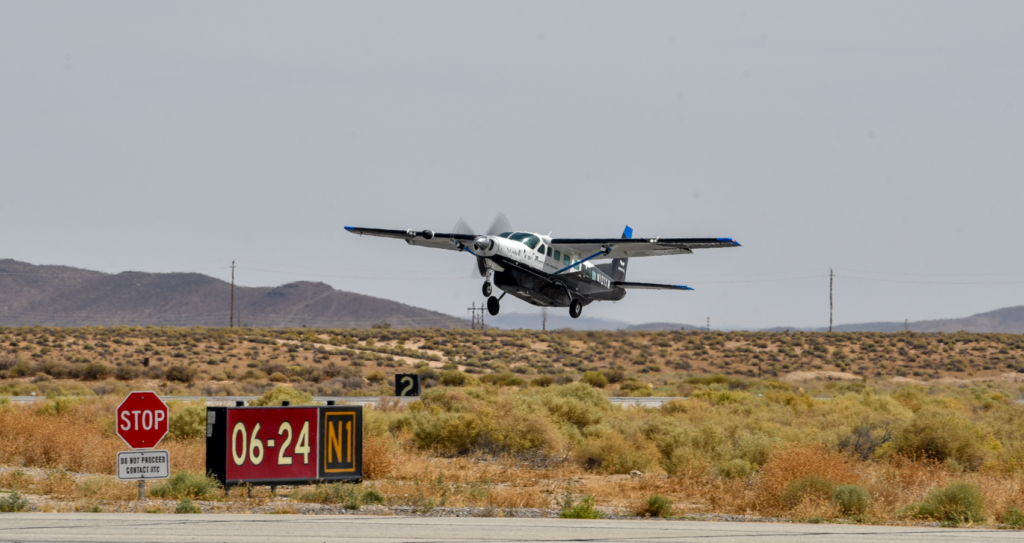
Joby, an AFWERX Autonomy Prime partner, takes off from Edwards Air Force Base, Calif., in its autonomous Cessna 208B Grand Caravan to deliver cargo to Southern California Logistics Airport in Victorville, Calif., during AGILE FLAG 24-3 on Aug. 7, 2024. AFWERX Autonomy Prime invited Joby to conduct autonomous flight demonstrations during AGILE FLAG and show Air Force leaders how autonomous aviation can contribute to the Agile Combat Employment, or ACE, concept. ACE is a proactive and reactive operational scheme of maneuver executed within threat timelines to increase survivability while generating combat power. (U.S. Air Force photo/Matthew Clouse)
During AGILE FLAG, the 23rd Wing from Moody Air Force Base, Georgia, and the 9th Reconnaissance Wing from Beale Air Force Base, California, tested their ability to generate combat air power while maneuvering and sustaining their forces in dynamic, contested environments across California and other locations in the western United States.
Both wings used Joby and Reliable Robotics’ autonomous flight technology, which allows a Cessna 208B Grand Caravan aircraft to taxi, take off, fly to a destination and land independently to deliver cargo such as aircraft parts and supplies. The aircraft can fly roughly 1,150 miles with 1,200 pounds of cargo.
“Previously, we faced a tough choice: either use a cargo aircraft with all the associated expenses or forgo the flight altogether, which created difficult decisions for warfighting commanders,” said Col. Max Bremer, Air Mobility Command Special Access Program management officer. “The return on investment with this technology is significant. By using it to handle smaller cargo, we can preserve cargo aircraft for more critical tasks like transporting large parts, engines, or weapons. This not only enhances the overall capability of the cargo fleet but also ensures they are used where they are most needed.”
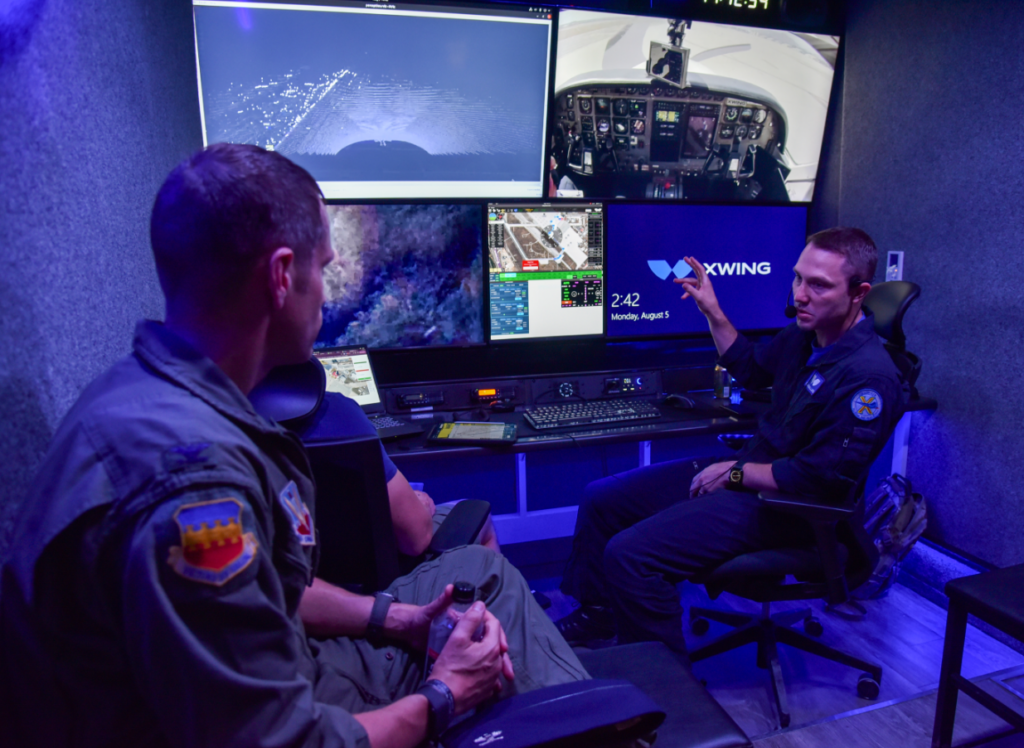
Craig Milliard, Joby flight test lead, gives a demonstration to Col. Kevin Hicok, 20th Fighter Wing commander, about their autonomous flight capabilities in the Joby ground control station during AGILE FLAG 24-3 at Mojave Air and Space Port, Calif., Aug. 5, 2024. AFWERX Autonomy Prime invited Joby to conduct autonomous flight demonstrations during AGILE FLAG and show Air Force leaders how autonomous aviation can contribute to the Agile Combat Employment, or ACE, concept. ACE is a proactive and reactive operational scheme of maneuver executed within threat timelines to increase survivability while generating combat power. (U.S. Air Force photo/Matthew Clouse)
Along with time saved, the Cessnas are much cheaper to operate compared to traditional Air Force cargo aircraft. According to the Fiscal Year 2023 Defense Department cost report, the operating cost per hour for a C-130J Hercules is $7,671, and the operating cost per hour for a C-17A Globemaster III is $20,941 per hour. These figures encompass direct expenses such as fuel, maintenance, and crew costs, though actual costs can vary based on specific mission requirements and operational conditions.
In comparison, the cost to operate an autonomous Cessna 208B Grand Caravan per hour is between $1,200 and $1,600, depending on the utilization.
“These aircraft are saving the Air Force time and money by getting assets where they need to be in a shorter amount of time,” said Staff Sgt. Miguel Sarmiento, 633d Logistics Readiness Squadron aircraft parts store supervisor. “Looking ahead, if the Air Force adopts autonomous aircraft for asset transport in forward locations, it will increase sorties and flying hours by reducing delays in aircraft maintenance.”
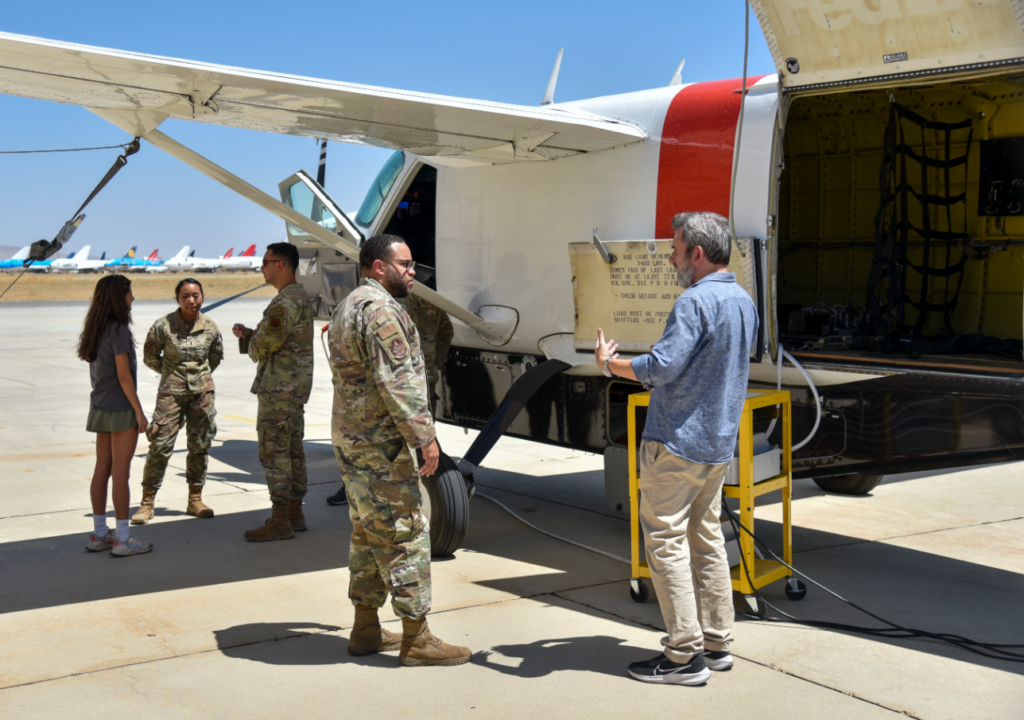
Reliable Robotics, an AFWERX Autonomy Prime partner, gives Airmen a tour of their autonomous Cessna 208B Grand Caravan during AGILE FLAG 24-3 at Mojave Air and Space Port, California, on Aug. 9, 2024. AFWERX Autonomy Prime invited Reliable Robotics to conduct autonomous flight demonstrations during AGILE FLAG and show Air Force leaders how autonomous aviation can contribute to the Agile Combat Employment (ACE) concept. ACE is a proactive and reactive operational scheme of maneuver executed within threat timelines to increase survivability while generating combat power. (U.S. Air Force photo/Matthew Clouse)
Autonomy Prime is a technology program within the Prime division of AFWERX, a directorate of the Air Force Research Laboratory. The program partners with the private sector to accelerate testing and affordably deliver game-changing technology to the warfighter.
AFWERX has awarded both Joby and Reliable Robotics Small Business Innovation Research Phase Two and Phase Three contracts to conduct autonomous flight trials and demonstrate the capability in an operationally relevant environment.
“AFWERX operates with a certain level of risk, as we often move forward before hard requirements are established — similar to how venture capitalists act before the market fully forms, hoping to find the next big thing,” said Ian Clowes of AFWERX Prime stakeholder engagement. “Our goal is to grow the defense industrial base through small and medium-sized companies.”

Reliable Robotics, an AFWERX Autonomy Prime partner, takes off from Mojave Air and Space Port, Calif., in its autonomous Cessna 208B Grand Caravan to deliver cargo to Travis Air Force Base, Calif., during AGILE FLAG 24-3 Aug. 8, 2024. AFWERX Autonomy Prime invited Reliable Robotics to conduct autonomous flight demonstrations during AGILE FLAG and show Air Force leaders how autonomous aviation can contribute to the Agile Combat Employment, or ACE, concept. ACE is a proactive and reactive operational scheme of maneuver executed within threat timelines to increase survivability while generating combat power. (U.S. Air Force phot / Matthew Clouse)
AFWERX Prime is pushing the envelope on commercial technologies that enhance last mile logistics for future combat operations. These technologies are in high demand as the Air Force reoptimizes for Agile Combat Employment. In February 2024, AFWERX Autonomy Prime invited Joby and Reliable Robotics to participate in AGILE FLAG Flag 24-1 and show Airmen the art of the possible.
“We had success, the vendors conducted several missions and there was significant publicity around the exercise,” Clowes added. “We wanted to build on that success by bringing both vendors back for AGILE FLAG 24-3, which imposes more realistic constraints on the training participants.”

Craig Milliard, Joby’s flight test lead, observes an autonomous flight from the Joby portable ground control station at Mojave Air and Space Port, Calif., as Joby’s autonomous Cessna 208B Grand Caravan takes off to Edwards Air Force Base, Calif., in the background during AGILE FLAG 24-3 on Aug. 9, 2024. AFWERX Autonomy Prime invited Joby to conduct autonomous flight demonstrations during AGILE FLAG and show Air Force leaders how autonomous aviation can contribute to the Agile Combat Employment, or ACE, concept. ACE is a proactive and reactive operational scheme of maneuver executed within threat timelines to increase survivability while generating combat power. (U.S. Air Force photo/Matthew Clouse)
AFWERX Autonomy Prime played a key role in the AGILE FLAG 24-3 planning conferences and worked closely with logistics personnel to familiarize them with the capability. During the weekly meetings leading up to the exercise, the team consistently communicated the arrival and potential of the technology, ensuring the wings were informed and prepared.
“We regularly emphasized that the capability was coming, what it could do and that it was theirs to use,” Clowes said. “There was definitely a ‘seeing is believing’ element. I’m sure they heard about us, but I don’t think they fully believed it until Sunday or Monday when the aircraft started arriving at Mojave and Edwards. It was like, ‘Here it is. Let’s get to work.’ Monday started a bit slower, but by Tuesday and Wednesday, we’ve been operating at full speed, fully supporting the wings.”
During AGILE FLAG 24-3, the 23rd Wing and 9th Reconnaissance Wing were tasked with generating fighter sorties to meet the requirements of a higher headquarters while also responding to adversary activities that complicated their mission. Throughout the exercise, cargo aircraft weren’t always available to deliver aircraft parts to keep fighter jets in the air.

Staff Sgt. Michael Hall, left, and Staff Sgt. Clayton Johnson, fuel specialists from the 9th Reconnaissance Wing, weigh supplies before loading into the autonomous Cessna 208B Grand Caravan from Reliable Robotics, an AFWERX Autonomy Prime partner, during AGILE FLAG 24-3 at Edwards Air Force Base, Calif., Aug. 5, 2024. AFWERX Autonomy Prime invited Reliable Robotics to conduct autonomous flight demonstrations during AGILE FLAG and show Air Force leaders how autonomous aviation can contribute to the Agile Combat Employment, or ACE, concept. ACE is a proactive and reactive operational scheme of maneuver executed within threat timelines to increase survivability while generating combat power. (U.S. Air Force photo/Giancarlo Casem)
For many Airmen involved in the exercise, the introduction of autonomous technology has been a game-changer. Joby and Reliable Robotics flew a total of 47 flights covering more than 6,600 miles in support of the exercise.
“The capability that the AFWERX team is providing through the Cessna is tremendous, [as] it allows us to move our equipment around the theater efficiently,” said Col. Charles Hanson, 9th Mission Support Group commander. “In this exercise scenario, where distance is a significant challenge, this capability is helping us overcome it.”
Capt. Mackenzie Thompson, 480th Sortie Generation flight commander, highlighted the impact of these innovations on her team’s ability to maintain and repair aircraft during the exercise.
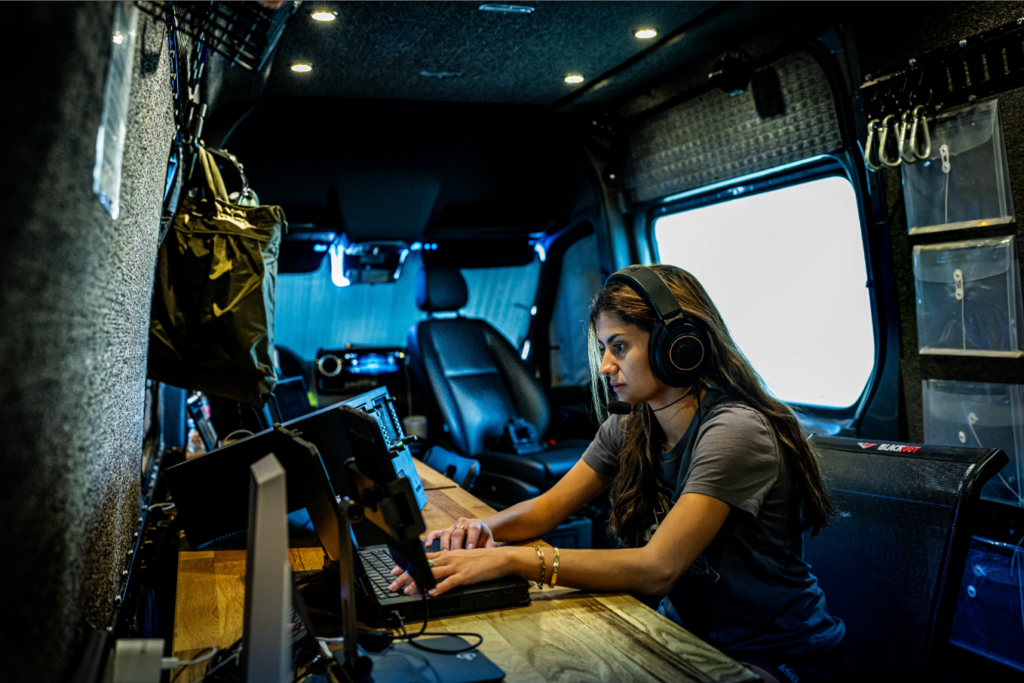
Danah Tommalieh, Reliable Robotics human systems integration engineer, monitors an autonomous flight from the Reliable Robotics ground control station during AGILE FLAG 24-3 at Mojave Air and Space Port, Calif., Aug. 7, 2024. AFWERX Autonomy Prime invited Reliable Robotics to conduct autonomous flight demonstrations during AGILE FLAG and show Air Force leaders how autonomous aviation can contribute to the Agile Combat Employment, or ACE, concept. ACE is a proactive and reactive operational scheme of maneuver executed within threat timelines to increase survivability while generating combat power. (U.S. Air Force photo/Joe Jones)
“My job is to ensure we have safe and reliable aircraft for the mission,” Thompson said. “AFWERX has been awesome in helping us transport parts quickly, which has saved us a lot of time and manpower.”
For AFWERX, the success of AGILE FLAG 24-3 represents more than just a milestone in technological development — it underscores the potential for transformative change in how the Air Force operates in contested environments.
“As we continue to refine and scale these capabilities, we hope to see them fully integrated into Air Force operations without the need for intermediaries,” Clowes said. “The future is about making these technologies an organic part of how the Air Force fights and wins.”
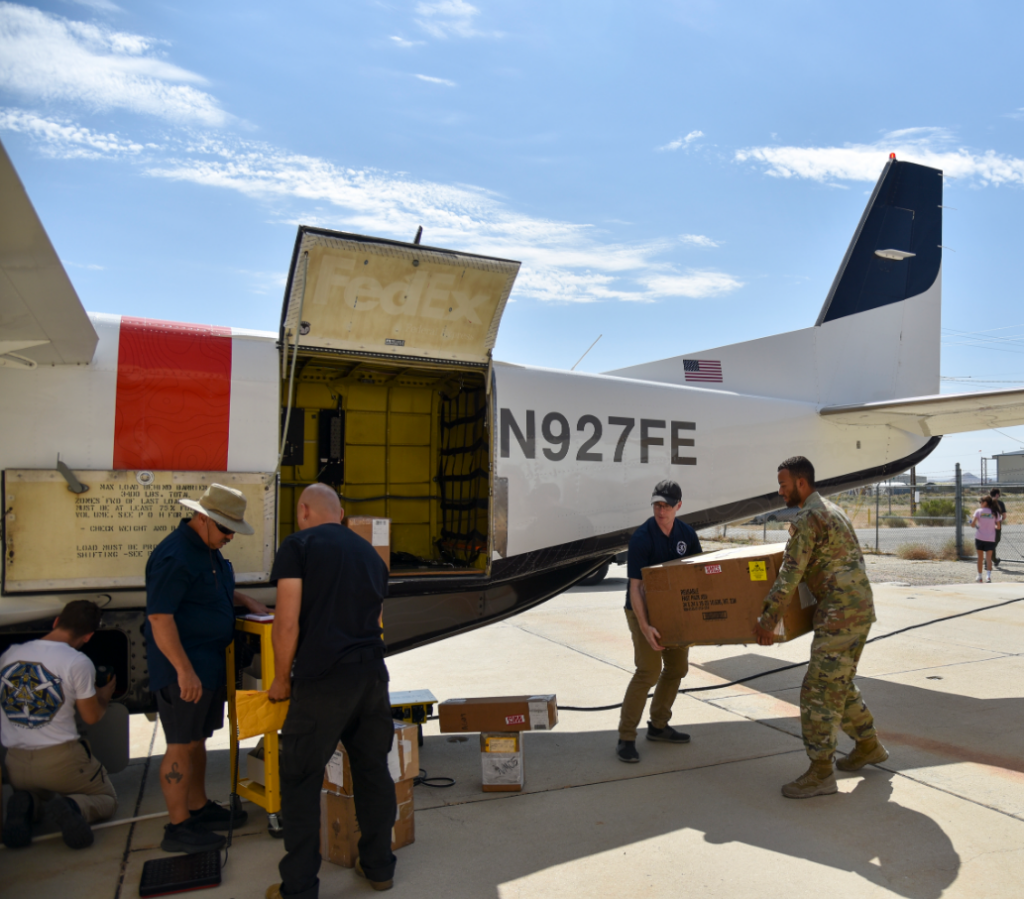
Chad Russell, AFWERX Agility Prime engineer, and Airman 1st Class Justin Lopez, a logistics readiness ground transportation specialist with the 23rd Wing, load cargo onto the autonomous Cessna 208B Grand Caravan from Reliable Robotics, an AFWERX Autonomy Prime partner, during AGILE FLAG 24-3 at Mojave Air and Space Port, Calif., Aug. 8, 2024. AFWERX Autonomy Prime invited Reliable Robotics to conduct autonomous flight demonstrations during AGILE FLAG and show Air Force leaders how autonomous aviation can contribute to the Agile Combat Employment, or ACE, concept. ACE is a proactive and reactive operational scheme of maneuver executed within threat timelines to increase survivability while generating combat power. (U.S. Air Force photo/Matthew Clouse)
About AFRL
The Air Force Research Laboratory is the primary scientific research and development center for the Department of the Air Force. AFRL plays an integral role in leading the discovery, development, and integration of affordable warfighting technologies for our air, space and cyberspace force. With a workforce of more than 12,500 across nine technology areas and 40 other operations across the globe, AFRL provides a diverse portfolio of science and technology ranging from fundamental to advanced research and technology development. For more information, visit www.afresearchlab.com.
About AFWERX
As the innovation arm of the DAF and a directorate within the Air Force Research Laboratory, AFWERX brings cutting-edge American ingenuity from small businesses and start-ups to address the most pressing challenges of the DAF. AFWERX employs approximately 370 military, civilian and contractor personnel at five hubs and sites executing an annual $1.4 billion budget. Since 2019, AFWERX has executed over 6,200 new contracts worth more than $4.7 billion to strengthen the U.S. defense industrial base and drive faster technology transition to operational capability. For more information, visit: www.afwerx.com.
